Palm Trees - Ganoderma
What is Ganoderma?
Ganoderma is a disease which infects all varieties of palm trees in Florida. One infected tree can infect all palm trees in the immediate area. The following phrase used by scientists when discussing Ganoderma, aptly describes the insiduous nature of this disease:
"Ganoderma is to palms what aids is to humans."
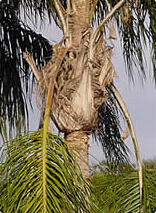 Close-up of queen's infected head appears to be strong, but weak fronds indicate early stages of Ganoderma
Close-up of queen's infected head appears to be strong, but weak fronds indicate early stages of Ganoderma 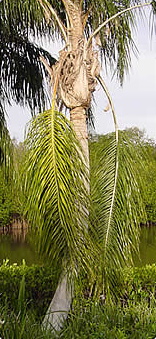 Curved palm showing first symptoms of Ganoderma drooping, yellowish lower fronds - show loss of vigor
Curved palm showing first symptoms of Ganoderma drooping, yellowish lower fronds - show loss of vigor Small conch - confirms the presence of Ganoderma. Conchs usually appear near the soil, but may also be found on the trunk or surface roots of a palm. The infected palm must be removed immediately to prevent the spread of infection to other palms.
Last Stages of Ganoderma
The once small white conch has developed to its maximum contagious stage, having released spores which will be carried by air currents to other palms. This fungus-like growth is a wound parasite which means you should protect your palms from being injured by weed whackers which cause wounds close to the ground. Be wary of poor landscape maintenance practices - lawn mowers and edgers can also cause damage which allows Ganoderma to develop.
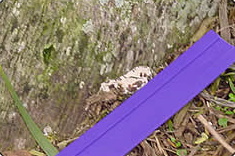
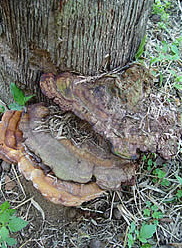
Even with good sanitation measures, i.e. saturation of the soil with bleach and fungicides after removal of an infected palm; removal of all wood chips and debris resulting from the disposal of the infected tree; allowing the soil to "rest" for a year before installing a replacement palm - or - the final resort, total soil replacement, Ganoderma will often affect a replacement palm.
 Disintegrating, shrunken, and dry, this root from an infected palm was unable to absorb nutrients and moisture from the soil.
Disintegrating, shrunken, and dry, this root from an infected palm was unable to absorb nutrients and moisture from the soil. Removal of Infected Palm
Sanitation is the major emphasis - root systems, stumps, and trunks should be removed immediately in an attempt to avoid spread of the disease.
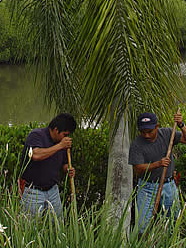
The upper portion of this infected palm was cut off 5 feet from the ground. Ganoderma infects trunks up to about 4+ feet. If the site permits, all sawdust and wood chips should be contained by using tarps.
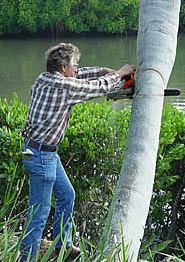
The remaining 5 feet of palm trunk must be dug out with as much of the root system as possible to limit soil removal and replacement

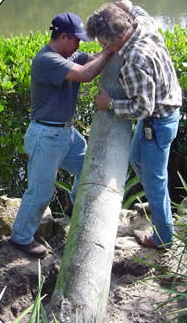
Bleach and hydrogen spray were used to fumigate the soil and immediate area and Bleach was used to disinfect all tools used to remove the infected tree.
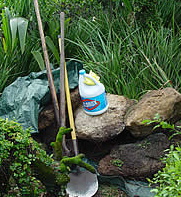
After treatment with fungicides and bleach throughout the year following removal of an infected Queen Palm, the soil which once surrounded the infected palm, is host to new Ganoderma bracts - this contaminated soil prevents the replanting of any species of palm tree.
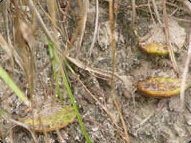
To-date there is no cure for Ganoderma!
Good landscape practice requires that all tools and shovels used in the garden be disinfected with Bleach during maintenance trimming of palm fronds and seed pods. NOTE: Your landscape maintenance crew should disinfect their saws and trimmers before moving from one palm to the next. The exact manner by which this disease spreads is still an unknown and until the mystery of Ganoderma is resolved, tools and saws should be disinfected before moving on to the next palm. Remember that Ganoderma in its early stage of infection cannot easily be detected and your crew can unknowingly spread the disease using tools that have not been disinfected.
Ganoderma is virulent - protect your palms and your neighbors's palms - remove any palm which shows early signs of this disease.